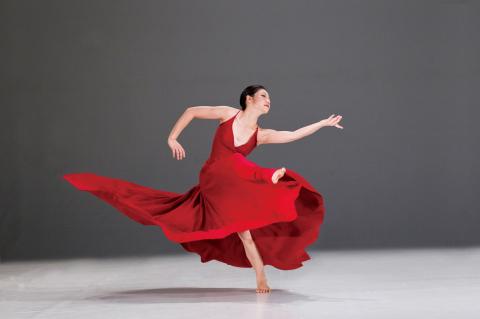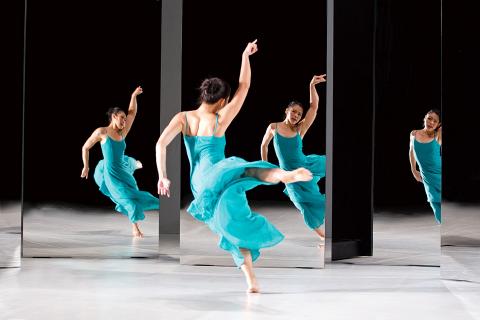Lin Hwai-min (林懷民) may self-deprecatingly say that he is getting too old, too tired, and too whatever to keep choreographing, but he still has a lot of surprises up his sleeves. And sometimes the surprise isn’t just for Cloud Gate Dance Theatre (雲門舞集) fans, but himself and his company.
To those for whom pieces like Moon Water (水月) or the Cursive (行草) trilogy symbolize Lin’s recent work for Cloud Gate, his latest production, How Can I Live On Without You (如果沒有你), will be an eye-opener. It is a love song to Taiwanese music of the past six decades, and a love song to his dancers and fans.
“Songs are a collective memory,” Lin said at a press conference back in September, shortly before the troupe departed for a multi-week tour of the US and a stint in London.

Photo courtesy of Liu Chen-hsiang
“Songs tell a history, you can tell an era from a song,” he said. “People will say: ‘Oh, I really loved that song,’ but people argue over the meaning.”
He also wanted to show audiences that Cloud Gate is not the same company as it was before, that it has a lot of younger faces.
Lin said he got the idea of using “modern” love songs while humming a line from the song How Can I Live On Without You (made famous by the late singer Bai Guang, 白光), in the shower and realizing how danceable it was. There was just one problem. Lin didn’t really know many popular songs; he had grown up listening to classical music. So he asked his dancers to each submit a list of favorite songs.

Photo courtesy of Liu Chen-hsiang
“Some I hadn’t heard before,” Lin said, adding that the late Lo Man-fei (羅曼菲) — one of the troupe’s original members and director of Cloud Gate 2 (雲門2) — was always trying to drag him to concerts by Wu Bai (伍佰) or other singers.
According to associate artistic director Lee Ching- chun (李靜君), her boss hadn’t heard most of the songs the dancers suggested.
“Mr Lin is always curious about what he doesn’t know,” Lee said in a telephone interview on Wednesday, adding that Lin was fascinated by “the journey of discovery, asking ‘Who’s that singer? Who’s that?’”
“He’s discovered a lot about the pop world, especially the words. As a writer, he’s very sensitive about words, so he was very interested the lyrics,” Lee said.
Since most of the songs were new to Lin, he didn’t play favorites when it came to selecting the 18 that would be in the show. The only considerations, he said, were the power of a song’s melody and whether it was danceable.
The songs certainly are an eclectic mix, ranging from Wu Bai, folk singer Tsai Chin (蔡琴), indie singer-songwriter Crowd Lu (盧廣仲), Fong Fei-fei (鳳飛飛) and Jay Chou (周杰倫) all the way back to 1940s crooner Bai Guang.
“Some of the dancers were disappointed that the songs they chose weren’t in the repertoire, but some were too nice to dance to, or sometimes just were not right,” Lee said, adding that Lin was still tweaking the playlist a month ago.
To link such disparate tunes together, Lin envisioned a kind of cabaret, with the dancers portraying a concert singer, a karaoke outing or a TV variety show.
It’s not just the music that’s so unusual for Cloud Gate. Lin’s style of working changed as well, Lee said, adding that it was very different from the way he choreographed the Cursive series.
“I’ve been here [with the company] for 28 years and this is the first time the studio was always full of laughter. It was the first time we saw Mr Lin swing his hips — because you know, he has to show the dancers what he wants, he doesn’t just tell them,” Lee said with a laugh. “Everyone who was in the studio feels the change.”
The creative mood was very different, less serious, with more interaction between Lee and the dancers and more give and take, she said.
“I keep telling the young dancers they don’t know how lucky they are that he is spending so much time with them. For some it’s their first solo, it’s so precious, this time with him,” she said. “He wants to get things right for them. It is a very special way [that] Mr Lin creates, finding what is right for each dancer.”
The costumes for the new production are also a departure. It’s not the first time the women have worn dresses of different colors — they did in Whisper of Flowers (花語) three years ago — but the vibrant hues and long lengths are certainly a rarity for the troupe.
Lee said Lin’s idea was that How Can I Live On Without You had to look like a “show,” so bright-colored dresses were his idea from the very beginning. When they started the costume design process, the worktable was strewn with color samples, she said.
The color choice for each dancer was made first. Leading lady Chou Chang-ning (周章佞), for example, wears a fabulously vibrant red dress. If the color choices didn’t work in the fabrics, however, the design team had to start all over again, not to mention that some dancers have two or three costume changes.
“The designer [Keith Lin (林秉豪)] was going crazy,” Lee said.
How Can I Live On Without You will run for 10 shows at the National Theater, beginning on Dec. 2. There will also be two performances each in Greater Taichung and Greater Kaohsiung at the end of next month. The show is about 75 minutes, plus a 15-minute intermission.
It may seem an unusual pairing for the company’s fall season to go from the joyful exuberance of How Can I Live On Without You to one of Lin’s darker pieces, but Portrait of the Families (家族合唱), which premiered in 1997, is also a love song of sorts, one dedicated to the Taiwanese and their history. Portrait, which tells the story of Taiwan from the Japanese colonial era through the early 1990s, explores human suffering and the nation’s efforts to come to grips with the past. It is as relevant today as it was in 1997.
The show features a lot of historical material — old photographs (including some from Lin’s family albums) of people, places and events, and voice recordings. While some of the multi-media presentation focuses on the 228 Massacre and the White Terror era, Lin says it is not political, though he did want to draw attention to photos such as one that shows a burned-out car on Dihua Street (迪化街) in 1947.
Dihua, in Taipei’s Dadaocheng (大稻埕) area, was “ground zero” for the 228 Incident, when personnel from the Taiwan Provincial Monopoly Bureau beat and arrested a cigarette vendor on Feb. 27, 1947, for selling illegal cigarettes, triggering riots and large-scale protests against the Chinese Nationalist Party (KMT) administration.
Portrait of the Families opens on Dec. 15 for a five-show run.
Exhibition Notes
What: Cloud Gate Dance Theatre, How Can I Live On Without You (如果沒有你)
When: Dec. 2 to Dec. 11 at 7:45pm and weekend matinees at 2:45pm; no performance on Dec. 5.
Where: National Theater, 21-1 Zhongshan S Rd, Taipei City (台北市中山南路21-1號)
Admission: NT$600 to NT$2,400; available at NTCH box office, online at www.artsticket.com.tw or ibon kiosks; the first weekend is already sold out
Additional performance: Dec. 23 and 24 at Taichung Chungshan Hall (台中市中山堂), 98 Syueshih Rd, Greater Taichung (台中市學士路98號) and Dec. 29 and 30 at Kaohsiung Cultural Center’s Chihteh Hall (高雄市立文化中心至德堂), 67 Wufu 1st Rd, Greater Kaohsiung, (高雄市五福一路67號). Remaining tickets for both cities range from NT$300 to NT$1,200; available online at www.artsticket.com.tw or 7-Eleven ibon kiosks
What: Cloud Gate Dance Theatre, Portrait of the Families (家族合唱)
When: Dec. 15 to Dec. 18 at 7:45pm, weekend matinees at 2:45pm
Where: National Theater, 21-1 Zhongshan S Rd, Taipei City (台北市中山南路21-1號)
Admission: NT$400 TO NT$2,400; available at NTCH box office, online at www.artsticket.com.tw or at 7-Eleven ibon kiosks

June 2 to June 8 Taiwan’s woodcutters believe that if they see even one speck of red in their cooked rice, no matter how small, an accident is going to happen. Peng Chin-tian (彭錦田) swears that this has proven to be true at every stop during his decades-long career in the logging industry. Along with mining, timber harvesting was once considered the most dangerous profession in Taiwan. Not only were mishaps common during all stages of processing, it was difficult to transport the injured to get medical treatment. Many died during the arduous journey. Peng recounts some of his accidents in

“Why does Taiwan identity decline?”a group of researchers lead by University of Nevada political scientist Austin Wang (王宏恩) asked in a recent paper. After all, it is not difficult to explain the rise in Taiwanese identity after the early 1990s. But no model predicted its decline during the 2016-2018 period, they say. After testing various alternative explanations, Wang et al argue that the fall-off in Taiwanese identity during that period is related to voter hedging based on the performance of the Democratic Progressive Party (DPP). Since the DPP is perceived as the guardian of Taiwan identity, when it performs well,

The Taiwan People’s Party (TPP) on May 18 held a rally in Taichung to mark the anniversary of President William Lai’s (賴清德) inauguration on May 20. The title of the rally could be loosely translated to “May 18 recall fraudulent goods” (518退貨ㄌㄨㄚˋ!). Unlike in English, where the terms are the same, “recall” (退貨) in this context refers to product recalls due to damaged, defective or fraudulent merchandise, not the political recalls (罷免) currently dominating the headlines. I attended the rally to determine if the impression was correct that the TPP under party Chairman Huang Kuo-Chang (黃國昌) had little of a

At Computex 2025, Nvidia CEO Jensen Huang (黃仁勳) urged the government to subsidize AI. “All schools in Taiwan must integrate AI into their curricula,” he declared. A few months earlier, he said, “If I were a student today, I’d immediately start using tools like ChatGPT, Gemini Pro and Grok to learn, write and accelerate my thinking.” Huang sees the AI-bullet train leaving the station. And as one of its drivers, he’s worried about youth not getting on board — bad for their careers, and bad for his workforce. As a semiconductor supply-chain powerhouse and AI hub wannabe, Taiwan is seeing